Role of Volcano-Sedimentary Basins in the Formation of Greenstone-Granitoid Belts in the West African Craton: A Numerical Model
Abstract
1. Introduction
2. Geological Setting
2.1. Geological Framework of the Leo-Man Shield
2.2. Geological Summary in South–Western Burkina Faso
2.3. Geological Summary in South-Western Burkina Faso
3. Tectonic Models: The Deformation of Greenstone–Granitoid Belts
4. Ambient Mantle Temperature (Tp)
5. Numerical Method and Model Setup
6. Thermo-Mechanical Modelling Results
6.1. Model200 and Model250
6.2. Model290
6.3. Model350 and Model400
6.4. Mode450
7. Discussion
7.1. The Mantle Potential Temperature
7.2. A New Tectonic Scenario
7.3. Implications for the Birimian Crust
7.4. Limitations and Perspectives
8. Conclusions
Acknowledgments
Author Contributions
Conflicts of Interest
Appendix A
| Reference | Hirdes et al. [28] | Ama Salah et al. [25] | Thomas et al. [29] | Galipp et al. [27] | Ama Salah et al. [25] | Soumaila [26] | Soumaila [26] |
|---|---|---|---|---|---|---|---|
| Sap_ID | 1074 | AS-393 | EC2036 | KG 18 | AS-5 | 755 | 810 |
| Location | Ghana Sefwi Belt | Niger Nigerian iptako | Ghana Wa-Larwa Belt | Ghana Sefwi Belt | Niger Nigerian Liptako | Niger Nigerian Liptako (Zawa Tondi) | Niger Nigerian Liptako (Zawa Tondi) |
| Rock Type | BASALT | BASALT | BASALT | BASALT | BASALT | BASALT | BASALT |
| latitude | 6 | 13.5 | 9.666 | 6.08 | 13.5 | 14 | 14 |
| longitude | −2.8 | 1.5 | −2.46 | −2.95 | 1.5 | 1 | 1 |
| SiO2 | 49.34 | 50.29 | 50.13 | 50.62 | 49.18 | 50.18 | 51.06 |
| TiO2 | 0.343 | 0.31 | 0.44 | 0.62 | 0.28 | 0.55 | 0.53 |
| Al2O3 | 14.58 | 16.25 | 14.06 | 14.23 | 14.03 | 14.24 | 13.3 |
| FeOTotal | 9.09 | 8.657071 | 9.4 | 9.64 | 10.57303 | 9.135 | 8.856 |
| MnO | 0.164 | 0.16 | 0.162 | 0.17 | 0.19 | 0.16 | 0.17 |
| MgO | 8.64 | 7.97 | 9.77 | 8.62 | 9.64 | 9.03 | 8.79 |
| CaO | 13.009 | 12.84 | 13.21 | 12.39 | 12.66 | 12.41 | 11.95 |
| Na2O | 2 | 1.4 | 1.46 | 1.85 | 1.23 | 1.43 | 2.42 |
| K2O | 0.188 | 0.01 | 0.28 | 0.1 | 0.08 | 0.13 | 0.32 |
| P2O5 | 0.034 | 0.04 | 0.03 | 0.07 | 0.14 | 0.16 | 0.15 |
| LOI | 2.1 | 2.31 | 0 | 1.82 | 1.91 | 1.47 | 1.33 |
References
- Baratoux, L.; Metelka, V.; Naba, S.; Jessell, M.W.; Grégoire, M.; Ganne, J. Juvenile Paleoproterozoic crust evolution during the Eburnean orogeny (∼2.2–2.0 Ga), western Burkina Faso. Precambrian Res. 2011, 191, 18–45. [Google Scholar] [CrossRef]
- Condie, K.C. Greenstones through time. In Archaean Crustal Evolution; Elsevier: Amsterdam, The Netherlands, 1997; Volume 11, pp. 85–120. [Google Scholar]
- Condie, K.C. Plate Tectonics and Crustal Evolution; Elsevier: Amsterdam, The Netherlands, 2013; pp. 99–104. [Google Scholar]
- Ganne, J.; Gerbault, M.; Block, S. Thermo-mechanical modeling of lower crust exhumation—Constraints from the metamorphic record of the Palaeoproterozoic Eburnean orogeny, West African Craton. Precambrian Res. 2014, 243, 88–109. [Google Scholar] [CrossRef]
- Glazner, A.F.; Bartley, J.M.; Coleman, D.S.; Gray, W.; Taylor, R.Z. Are plutons assembled over millions of years by amalgamation from small magma chambers? GSA Today 2004, 14, 4–11. [Google Scholar] [CrossRef]
- Bittner, D.; Schmeling, H. Numerical modelling of melting processes and induced diapirism in the lower crust. Geophys. J. Int. 1995, 123, 59–70. [Google Scholar] [CrossRef]
- Petford, N.; Cruden, A.R.; McCaffrey, K.J.W.; Vigneresse, J.L. Granite magma formation, transport and emplacement in the Earth’s crust. Nature 2000, 408, 669–673. [Google Scholar] [CrossRef] [PubMed]
- Miller, C.F.; Watson, E.B.; Harrison, T.M. Perspectives on the source, segregation and transport of granitoid magmas. Trans. R. Soc. Edinb. Earth Sci. 1988, 79, 135–156. [Google Scholar] [CrossRef]
- Block, S.; Ganne, J.; Baratoux, L.; Zeh, A.; Parra-Avila, A.L.; Jessell, M.; Ailleres, L.; Siebenaller, L. Petrological and geochronological constraints on lower crust exhumation during Paleoproterozoic (Eburnean) orogeny, NW Ghana, West African craton. J. Metamorph. Geol. 2015, 33, 463–494. [Google Scholar] [CrossRef]
- Jessell, M.W.; Amponsah, P.O.; Baratoux, L.; Asiedu, D.K.; Loh, G.K.; Ganne, J. Crustal-scale transcurrent shearing in the Paleoproterozoic Sefwi-Sunyani-Comoé region, West Africa. Precambrian Res. 2012, 212–213, 155–168. [Google Scholar] [CrossRef]
- Oberthür, T.; Vetter, U.; Davis, D.W.; Amanor, J.A. Age constraints on gold mineralization and Paleoproterozoic crustal evolution in the Ashanti belt of southern Ghana. Precambrian Res. 1998, 89, 129–143. [Google Scholar] [CrossRef]
- De Kock, G.S.; Armstrong, R.A.; Siegfried, H.P.; Thomas, E. Geochronology of the Birim Supergroup of the West African craton in the Wa-Bolé region of west-central Ghana: Implications for the stratigraphic framework. J. Afr. Earth Sci. 2011, 59, 1–40. [Google Scholar] [CrossRef]
- Milési, J.P.; Ledru, P.; Feybesse, J.L.; Dommanget, A.; Marcoux, E. Early Proterozoic ore deposits and tectonics of the Birimian orogenic belt, West Africa. Precambrian Res. 1992, 58, 305–344. [Google Scholar] [CrossRef]
- Hirdes, W.; Davis, D.W.; Lüdtke, G.; Konan, G. Two generations of Birimian (Paleoproterozoic) volcanic belts in northeastern Côte d’Ivoire (West Africa): Consequences for the “Birimian controversy”. Precambrian Res. 1996, 80, 173–191. [Google Scholar] [CrossRef]
- Vidal, M.; Delor, C.; Pouclet, A.; Simeon, Y.; Alric, G. Evolution géodynamique de l‘Afrique de l‘Ouest entre 2.2 Ga et 2 Ga; le style archéen’ des ceintures vertes et des ensembles sedimentaires birimiens du nord-est de la Côte-d’Ivoire. Bulletin de la Société géologique de France 1996, 167, 307–319. [Google Scholar]
- Vidal, M.; Gumiaux, C.; Cagnard, F.; Pouclet, A.; Ouattara, G.; Pichon, M. Evolution of a Paleoproterozoic weak type orogeny in the West African Craton (Ivory Coast). Tectonophysics 2009, 477, 145–159. [Google Scholar] [CrossRef]
- Doumbia, S.; Pouclet, A.; Kouamelan, A.; Peucat, J.J.; Vidal, M.; Delor, C. Petrogenesis of juvenile-type Birimian (Paleoproterozoic) granitoids in Central Côte-d’Ivoire, West Africa: Geochemistry and geochronology. Precambrian Res. 1998, 123, 47–65. [Google Scholar] [CrossRef]
- Feybesse, J.L.; Billa, M.; Guerrot, C.; Duguey, E.; Lescuyer, J.L.; Milesi, J.P.; Bouchot, V. The paleoproterozoic Ghanaian province: Geodynamic model and ore controls, including regional stress modeling. Precambrian Res. 2006, 149, 149–196. [Google Scholar] [CrossRef]
- Hein, K.A.A. Succession of structural events in the Goren greenstone belt (Burkina Faso): Implications for West African tectonics. J. Afr. Earth Sci. 2010, 56, 83–94. [Google Scholar] [CrossRef]
- Leube, A.; Hirdes, W.; Mauer, R.; Kesse, G.O. The early Proterozoic Birimian Supergroup of Ghana and some aspects of its associated gold mineralization. Precambrian Res. 1990, 46, 139–165. [Google Scholar] [CrossRef]
- Agyei Duodu, J.; Loh, G.K.; Boamah, K.O. Geological Map of Ghana 1:1,000,000; Geological Survey Department of Ghana (GSD): Accra, Ghana, 2009.
- Amponsah, P.O.; Salvi, S.; Béziat, D.; Siebenaller, L.; Baratoux, L.; Jessell, M.W. Geology and geochemistry of the shear hosted Julie deposit, NW Ghana. J. Afr. Earth Sci. 2015, 112, 505–523. [Google Scholar] [CrossRef]
- Lüdtke, G.; Hirdes, W.; Konan, G.; Koné, Y.; Yao, C.; Diarra, S.; Zamblé, Z. Géologie de la région Haute Comoé Nord—Feuilles Kong (4b et 4d) et Téhini-Bouna (3a à 3d); Bulletin 1; Bundesanstalt für Geowissenschaften und Rohstoffe: Hanover, Germany, 1998. [Google Scholar]
- Milési, J.P.; Feybesse, J.L.; Pinna, P. Geological map of Africa 1:10,000,000, SIGAfrique project. In Proceedings of the 20th Conference of African Geology, Orleans, France, 2–7 June 2004. [Google Scholar]
- Ama Salah, I.; Liegeois, J.P.; Pouclet, A. Evolution of a Birimian oceanic island arc of Nigerian liptako (Sirba): Geology, geochronology and geochemistry. J. Afr. Earth Sci. 1996, 22, 235–254. [Google Scholar] [CrossRef]
- Soumaila, A. Etude Structurale, Pétrographique et Géochimique de la Ceinture Birimienne de Diagorou-Darbani Liptako, Niger Occidental (Afrique de l’ouest). Ph.D. Thesis, Université de Franche-Comté, Besançon, France, 2000. [Google Scholar]
- Galipp, K.; Klemd, R.; Hirdes, W. Metamorphism and geochemistry of the Paleoproterozoic Birimian Sefwi volcanic belt (Ghana, West Africa). Geol. Jahrb. 2003, 111, 151–191. [Google Scholar]
- Hirdes, W.; Konan, K.G.; N’Da, D.; Okou, A.; Sea, P.; Zamble, Z.B.; Davis, D.W. Geology of the Northern Portion of the Oboisso Area, Côte d’Ivoire. Sheets 4A, 4B, 4B BIS, 4; Direction de la Géologie, Abidjan, Côte d’Ivoire and Bundesanstalt für Geowissenschaften und Rohstoffe: Hanover, Germany, 2007. [Google Scholar]
- Thomas, E.; De Kock, G.S.; Baglow, N.; Viljoen, J.; Siaka, Z. Geological Map Explanation Map Sheet 0903B (1:100,000); Mining Sector Support Programme; CGS, BRGM, Geoman, GSD: Accra, Ghana, 2009.
- Pavlis, N.K.; Holmes, S.A.; Kenyon, S.C.; Factor, J.K. The development and evaluation of the Earth Gravitational Model 2008 (EGM2008). J. Geophys. Res. Solid Earth 2012, 117. [Google Scholar] [CrossRef]
- Rose, P.K.; Eriksson, P.G.; Sarkar, S.; Wright, D.T.; Samanta, P.; Mukhopadhyay, S.; Mandal, S.; Banerjee, S.; Altermann, W. Sedimentation patterns during the Precambrian: A unique record? Mar. Pet. Geol. 2012, 33, 34–68. [Google Scholar]
- Gorman, B.E.; Pearce, T.H.; Birkett, T.C. On the structure of Archaean greenstone belts. Precambrian Res. 1978, 6, 23–41. [Google Scholar] [CrossRef]
- Chardon, D.; Choukroune, P.; Jayananda, M. Strain patterns, décollement and incipient sagducted greenstone terrains in the Archaean Dharwar craton (south India). J. Struct. Geol. 1996, 18, 991–1004. [Google Scholar] [CrossRef]
- Jessell, M.W.; Begg, G.C.; Miller, M.S. The geophysical signatures of the West African Craton. Precambrian Res. 2016, 274, 3–24. [Google Scholar] [CrossRef]
- Dioh, E.; Béziat, D.; Debat, P.; Grégoire, M.; Ngom, P.M. Diversity of the Palaeoproterozoic granitoids of the Kédougou inlier (Eastern Sénégal): Petrographical and geochemical constraints. J. Afr. Earth Sci. 2006, 44, 351–371. [Google Scholar] [CrossRef]
- Lompo, M. Geodynamic evolution of the 2.25-2.0 Ga Palaeoproterozoic magmatic rocks in the Man-Leo Shield of the West African Craton. A model of subsidence of an oceanic plateau. Geol. Soc. Lond. Spec. Publ. 2009, 323, 231–254. [Google Scholar] [CrossRef]
- Boher, M.; Abouchami, W.; Michard, A.; Albarede, F.; Arndt, N.T. Crustal growth in West Africa at 2.1 Ga. J. Geophys. Res. Solid Earth 1992, 97, 345–369. [Google Scholar] [CrossRef]
- Thompson, R.N.; Gibson, S.A. Transient high temperatures in mantle plume heads inferred from magnesian olivines in Phanerozoic picrites. Nature 2000, 407, 502–506. [Google Scholar] [CrossRef] [PubMed]
- Putirka, K.D.; Perfit, M.; Ryerson, F.J.; Jackson, M.G. Ambient and excess mantle temperatures, olivine thermometry, and active vs. passive upwelling. Chem. Geol. 2007, 241, 177–206. [Google Scholar] [CrossRef]
- Herzberg, C.; Condie, K.; Korenaga, J. Thermal history of the Earth and its petrological expression. Earth Planet. Sci. Lett. 2010, 292, 79–88. [Google Scholar] [CrossRef]
- Herzberg, C. Basalts as temperature probes of Earth’s mantle. Geology 2011, 39, 1179–1180. [Google Scholar] [CrossRef]
- Herzberg, C.; Asimow, P.D. PRIMELT3 MEGA. XLSM software for primary magma calculation: Peridotite primary magma MgO contents from the liquidus to the solidus. Geochem. Geophys. Geosyst. 2015, 16, 563–578. [Google Scholar] [CrossRef]
- Herzberg, C.; Asimow, P.D. Petrology of some oceanic island basalts: PRIMELT2. XLS software for primary magma calculation. Geochem. Geophys. Geosyst. 2008, 9, Q09001. [Google Scholar] [CrossRef]
- Moresi, L.; Dufour, F.; Mühlhaus, H.B. A Lagrangian integration point finite element method for large deformation modeling of viscoelastic geomaterials. J. Comput. Phys. 2003, 184, 476–497. [Google Scholar] [CrossRef]
- Moresi, L.; Quenette, S.; Lemiale, V.; Meriaux, C.; Appelbe, B.; Muhlhaus, H. Computational approaches to studying non-linear dynamics of the crust and mantle. Phys. Earth Planet. Inter. 2007, 163, 69–82. [Google Scholar] [CrossRef]
- De Smet, J.H.; Van den Berg, A.P.; Vlaar, N.J. Stability and growth of continental shields in mantle convection models including recurrent melt production. Tectonophysics 1998, 296, 15–29. [Google Scholar] [CrossRef]
- Feng, X.; Amponsah, P.O.; Martin, R.; Ganne, J.; Jessell, M.W. 3-D numerical modelling of the influence of pre-existing faults and boundary conditions on the distribution of deformation: Example of North-Western Ghana. Precambrian Res. 2016, 274, 161–179. [Google Scholar] [CrossRef]
- Mckenzie, D.; Jackson, J.; Priestley, K. Thermal structure of oceanic and continental lithosphere. Earth Planet. Sci. Lett. 2005, 233, 337–349. [Google Scholar] [CrossRef]
- Wang, K.; Burov, E.; Gumiaux, C.; Chen, Y.; Lu, G.; Mezri, L.; Zhao, L. Formation of metamorphic core complexes in non-over-thickened continental crust: A case study of Liaodong Peninsula (East Asia). Lithos 2015, 238, 86–100. [Google Scholar] [CrossRef]
- Ranalli, G. Rheology of the Earth; Springer Science & Business Media: Berlin, Germany, 1995; p. 413. [Google Scholar]
- Peace, A.; McCaffrey, K.; Imber, J.; Hobbs, R.; van Hunen, J.; Gerdes, K. Quantifying the influence of sill intrusion on the thermal evolution of organic-rich sedimentary rocks in nonvolcanic passive margins: An example from ODP 210-1276, offshore Newfoundland, Canada. Basin Res. 2017, 29, 249–265. [Google Scholar] [CrossRef]
- Gerya, T.V.; Perchuk, L.L.; Burg, J.P. Transient hot channels: Perpetrating and regurgitating ultrahigh-pressure, high-temperature crust-mantle associations in collision belts. Lithos 2008, 103, 236–256. [Google Scholar] [CrossRef]
- Pinkerton, H.; Stevenson, R.J. Methods of determining the rheological properties of magmas at sub-liquidus temperatures. J. Volcanol. Geotherm. Res. 1992, 53, 47–66. [Google Scholar] [CrossRef]
- Wang, D.; Lu, X.; Song, Y.; Shao, R.; Qi, T. Influence of the temperature dependence of thermal parameters of heat conduction models on the reconstruction of thermal history of igneous-intrusion-bearing basins. Comput. Geosci. 2010, 36, 1339–1344. [Google Scholar] [CrossRef]
- Rey, P.F.; Teyssier, C.; Whitney, D.L. The role of partial melting and extensional strain rates in the development of metamorphic core complexes. Tectonophysics 2009, 477, 135–144. [Google Scholar] [CrossRef]
- Maluski, H.; Matte, P. Ages of alpine tectonometamorphic events in the northwestern Himalaya (Northern Pakistan) by 39Ar/40Ar method. Tectonics 1984, 3, 1–18. [Google Scholar] [CrossRef]
- Prelević, D.; Jacob, D.E.; Foley, S.F. Recycling plus: A new recipe for the formation of Alpine-Himalayan orogenic mantle lithosphere. Earth Planet. Sci. Lett. 2013, 362, 187–197. [Google Scholar] [CrossRef]
- Ganne, J.; De Andrade, V.; Weinberg, R.F.; Vidal, O.; Dubacq, B.; Kagambega, N.; Naba, S.; Baratoux, L.; Jessell, M.; Allibon, J. Modern-style plate subduction preserved in the Palaeoproterozoic West African craton. Nat. Geosci. 2012, 5, 60–65. [Google Scholar] [CrossRef]
- Willett, S.; Beaumont, C.; Fullsack, P. Mechanical model for the tectonics of doubly vegent compressional orogens. Geology 1993, 21, 371–374. [Google Scholar] [CrossRef]
- Burg, J.P.; Ford, M. Progeny through time: An overview. Geol. Soc. Lond. Spec. Publ. 1997, 121, 1–17. [Google Scholar] [CrossRef]
- Anderson, D.L. Large igneous provinces, delamination, and fertile mantle. Elements 2005, 1, 271–275. [Google Scholar] [CrossRef]
- Abbott, D.; Burgess, L.; Longhi, J.; Smith, W.H. An empirical thermal history of the Earth’s upper mantle. J. Geophys. Res. 1994, 99, 13835–13850. [Google Scholar] [CrossRef]
- Clouser, R.H.; Langston, C.A. Upper mantle structure of southern Africa from P waves. J. Geophys. Res. Solid Earth 1990, 95, 17403–17415. [Google Scholar] [CrossRef]
- Artemieva, I.M.; Mooney, W.D. Thermal thickness and evolution of Precambrian lithosphere: A global study. J. Geophys. Res. Solid Earth 2001, 106, 16387–16414. [Google Scholar] [CrossRef]
- Qiu, X.; Priestley, K.; McKenzie, D. Average lithospheric structure of southern Africa. Geophys. J. Int. 1996, 127, 563–581. [Google Scholar] [CrossRef]
- De Beer, J.H.; Meyer, R. Geophysical characteristics of the Namaqua-Natal Belt and its boundaries, South Africa. J. Geodyn. 1984, 1, 473–494. [Google Scholar] [CrossRef]
- Durrheim, R.J.; Mooney, W.D. Evolution of the Precambrian lithosphere: Seismological and geochemical constraints. J. Geophys. Res. Solid Earth 1994, 99, 15359–15374. [Google Scholar] [CrossRef]
- Ross, G.M.; Eaton, D.W.; Boerner, D.E.; Miles, W. Tectonic entrapment and its role in the evolution of continental lithosphere: An example from the Precambrian of western Canada. Tectonics 2000, 19, 116–134. [Google Scholar] [CrossRef]
- Korenaga, J. Archaean geodynamics and the thermal evolution of Earth. Geophys. Monogr.-Am. Geophys. Union 2006, 164, 7–32. [Google Scholar]
- Abbott, D.; Mooney, W. The structural and geochemical evolution of the continental crust: Support for the oceanic plateau model of continental growth. Rev. Geophys. 1995, 33, 231–242. [Google Scholar] [CrossRef]
- Choukroune, P.; Ludden, J.N.; Chardon, D.; Calvert, A.J.; Bouhallier, H. Archaean crustal growth and tectonic processes; a comparison of the Superior Province, Canada and the Dharwar Craton, India. Geol. Soc. Lond. Spec. Publ. 1997, 121, 63–98. [Google Scholar] [CrossRef]
- Van Hunen, J.; Van den Berg, A.P. Plate tectonics on the early Earth: Limitations imposed by strength and buoyancy of subducted lithosphere. Lithos 2008, 103, 217–235. [Google Scholar] [CrossRef]
- Pons, J.; Barbey, P.; Dupuis, D.; Leger, J.M. Mechanisms of pluton emplacement and structural evolution of a 2.1 Ga juvenile continental crust: The Birimian of southwestern Niger. Precambrian Res. 1995, 70, 281–301. [Google Scholar] [CrossRef]
- Crameri, F.; Tackley, P.J. Spontaneous development of arcuate single–sided subduction in global 3-D mantle convection models with a free surface. J. Geophys. Res. Solid Earth 2014, 119, 5921–5942. [Google Scholar] [CrossRef]
- Cashman, K.V.; Sparks, S.J.; Blundy, J.D. Vertically extensive and unstable system: A unified view of igneous processes. Science 2017, 355. [Google Scholar] [CrossRef] [PubMed]
- Ganne, J.; Bachmann, O.; Feng, X. Deep into magma plumbing systems: Interrogating the crystal cargo of volcanic deposits. Geology, in press.
- Rudnick, R.L. Making continental crust. Nature 1995, 378, 571–577. [Google Scholar] [CrossRef]
- Smithies, R.H.; Champion, D.C. The Archaean high-Mg diorite suite: Links to tonalite-trondhjemite-granodiorite magmatism and implications for early Archaean crustal growth. J. Petrol. 2000, 41, 1653–1671. [Google Scholar] [CrossRef]
- Martin, H.; Smithies, R.H.; Rapp, R.; Moyen, J.F.; Champion, D. An overview of adakite, tonalite-trondhjemite-granodiorite (TTG), and sanukitoid: Relationships and some implications for crustal evolution. Lithos 2005, 79, 1–24. [Google Scholar] [CrossRef]
- Moyen, J.F. The composite Archaean grey gneisses: Petrological significance, and evidence for a non-unique tectonic setting for Archaean crustal growth. Lithos 2011, 123, 21–36. [Google Scholar] [CrossRef]
- Martin, H. Effect of steeper Archaean geothermal gradient on geochemistry of subduction-zone magmas. Geology 1986, 14, 753–756. [Google Scholar] [CrossRef]
- Martin, H.; Moyen, J.F.; Rapp, R. The sanukitoid series: Magmatism at the Archaean-Proterozoic transition. Earth Environ. Sci. Trans. R. Soc. Edinb. 2009, 100, 15–33. [Google Scholar] [CrossRef]
- Condie, K.C. TTGs and adakites: Are they both slab melts? Lithos 2005, 80, 33–44. [Google Scholar] [CrossRef]
- Zhao, J.H.; Zhou, M.F. Neoproterozoic adakitic plutons in the northern margin of the Yangtze Block, China: Partial melting of a thickened lower crust and implications for secular crustal evolution. Lithos 2008, 104, 231–248. [Google Scholar] [CrossRef]
- Huang, X.L.; Xu, Y.G.; Lan, J.B.; Yang, Q.J.; Luo, Z.Y. Neoproterozoic adakitic rocks from Mopanshan in the western Yangtze Craton: Partial melts of a thickened lower crust. Lithos 2009, 112, 367–381. [Google Scholar] [CrossRef]
- Vanderhaeghe, O. Melt segragation, pervasive melt migration and magma mobility in the continental crust: The structural record from pores to orogens. Phys. Chem. Earth Part A Solid Earth Geod. 2001, 26, 213–223. [Google Scholar] [CrossRef]
- Maierová, P.; Lexa, O.; Schulmann, K.; Štípská, P. Contrasting tectono-metamorphic evolution of orogenic lower crust in the Bohemian Massif: A numerical model. Gondwana Res. 2014, 25, 509–521. [Google Scholar] [CrossRef]
- Otto, C.; Kempka, T.; Kapusta, K.; Stańczyk, K. Fault Reactivation Can Generate Hydraulic Short Circuits in Underground Coal Gasification—New Insights from Regional-Scale Thermo-Mechanical 3D Modeling. Minerals 2016, 6, 101. [Google Scholar] [CrossRef]
- Feng, X.; Jessell, M.W.; Amponsah, P.O.; Martin, R.; Ganne, J.; Liu, D.; Batt, E.G. Effect of strain-weakening on Oligocene-Miocene self-organization of the Australian-Pacific plate boundary fault in southern New Zealand: Insights from numerical modelling. J. Geodyn. 2016. [Google Scholar] [CrossRef]
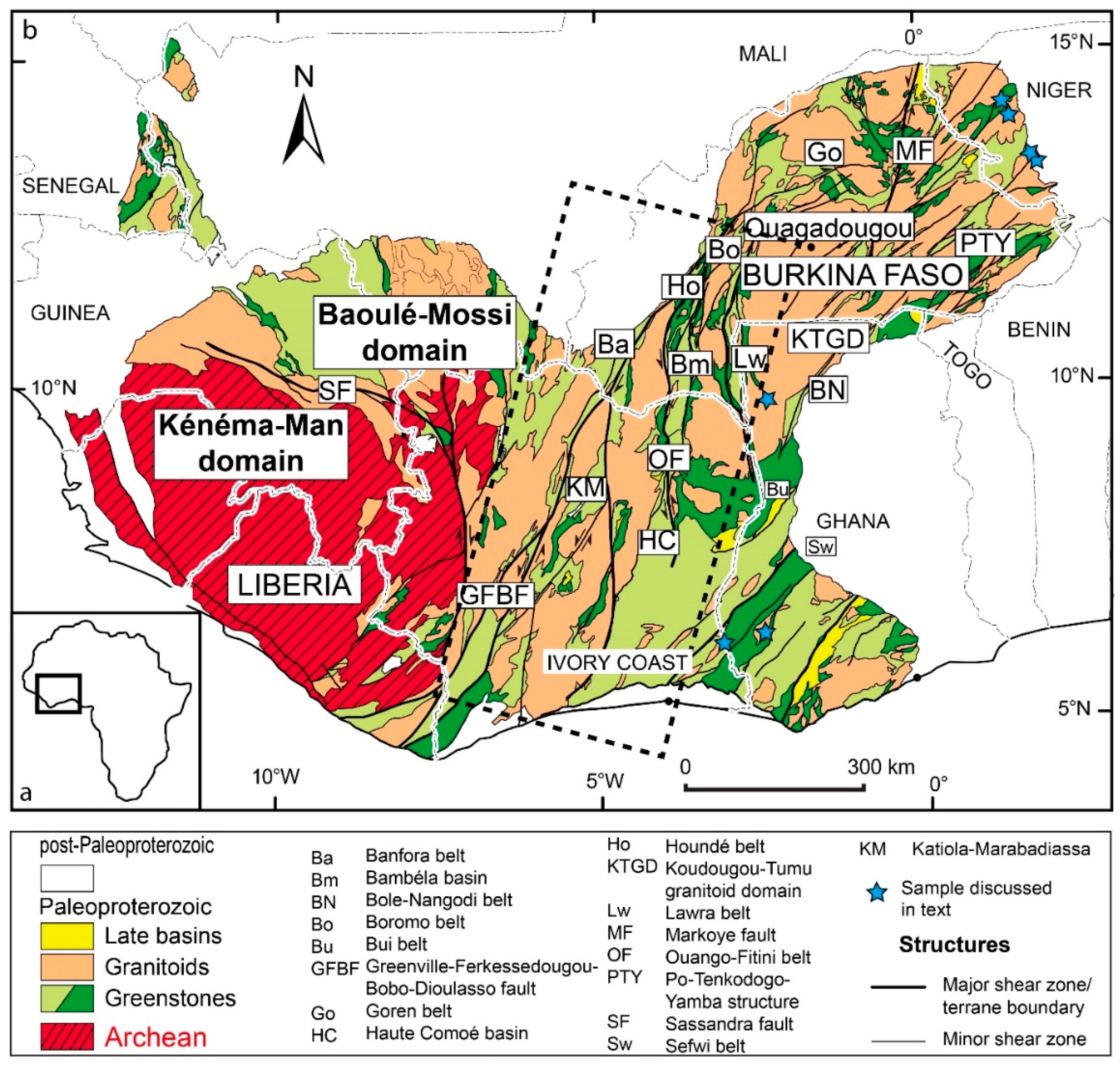
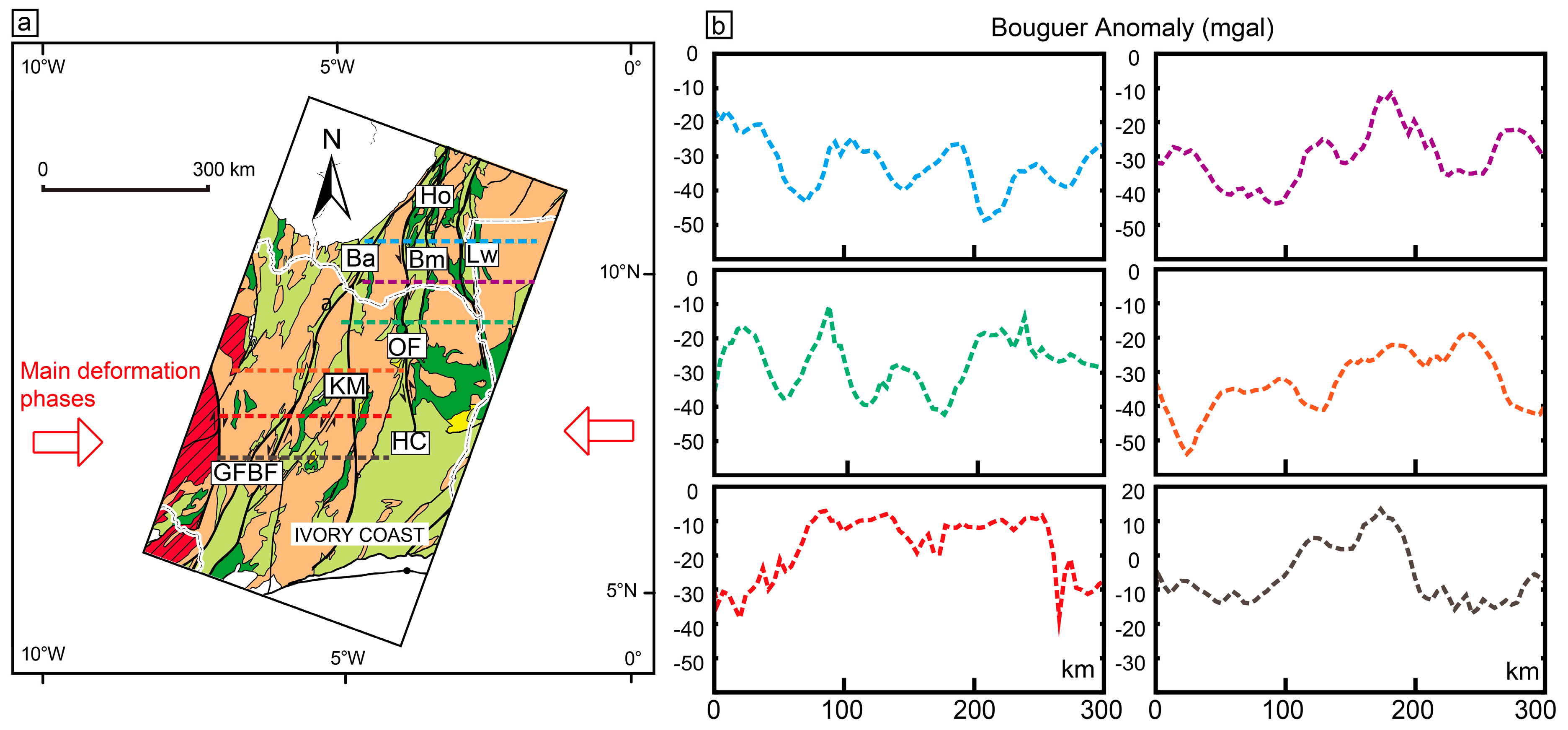
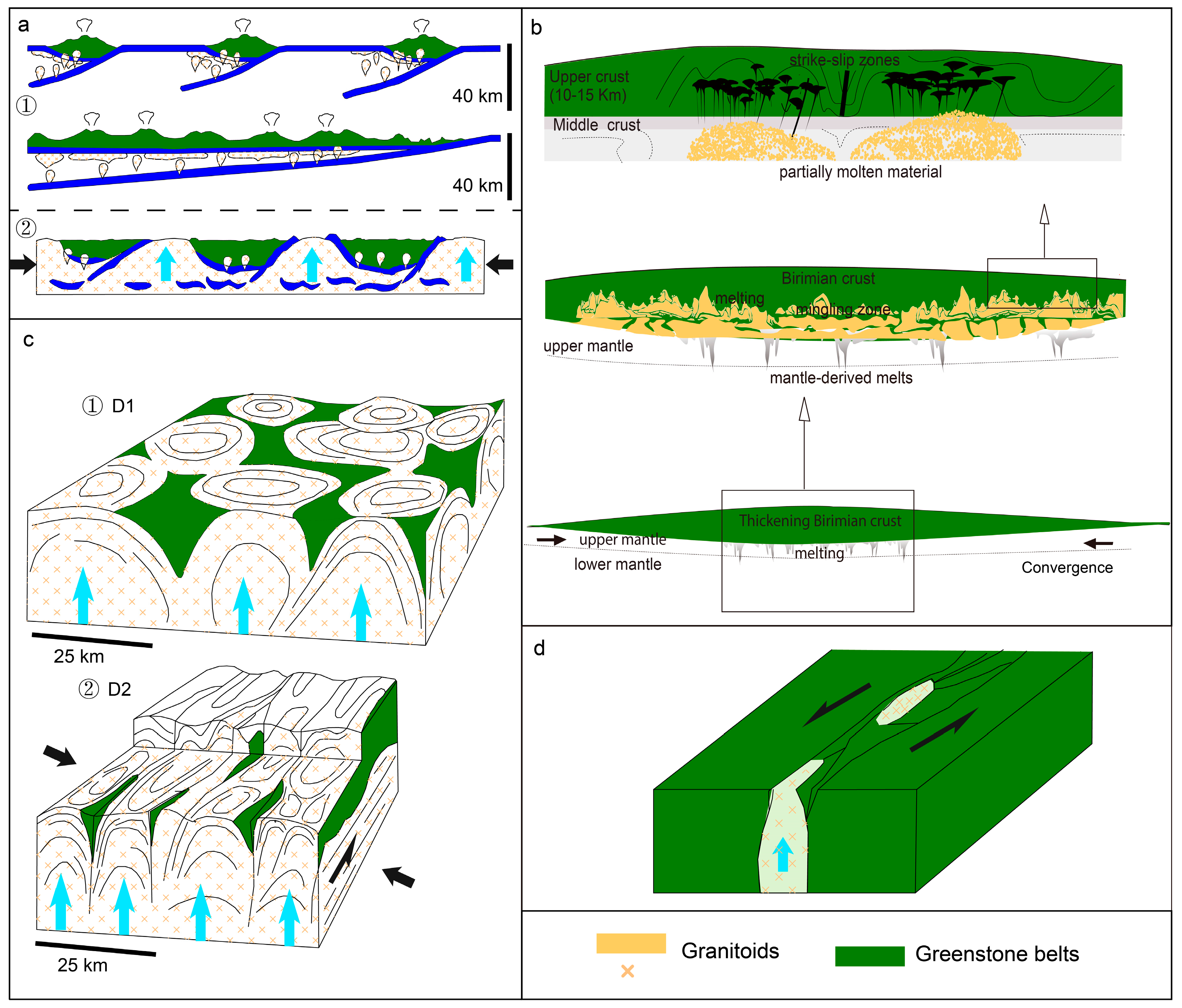
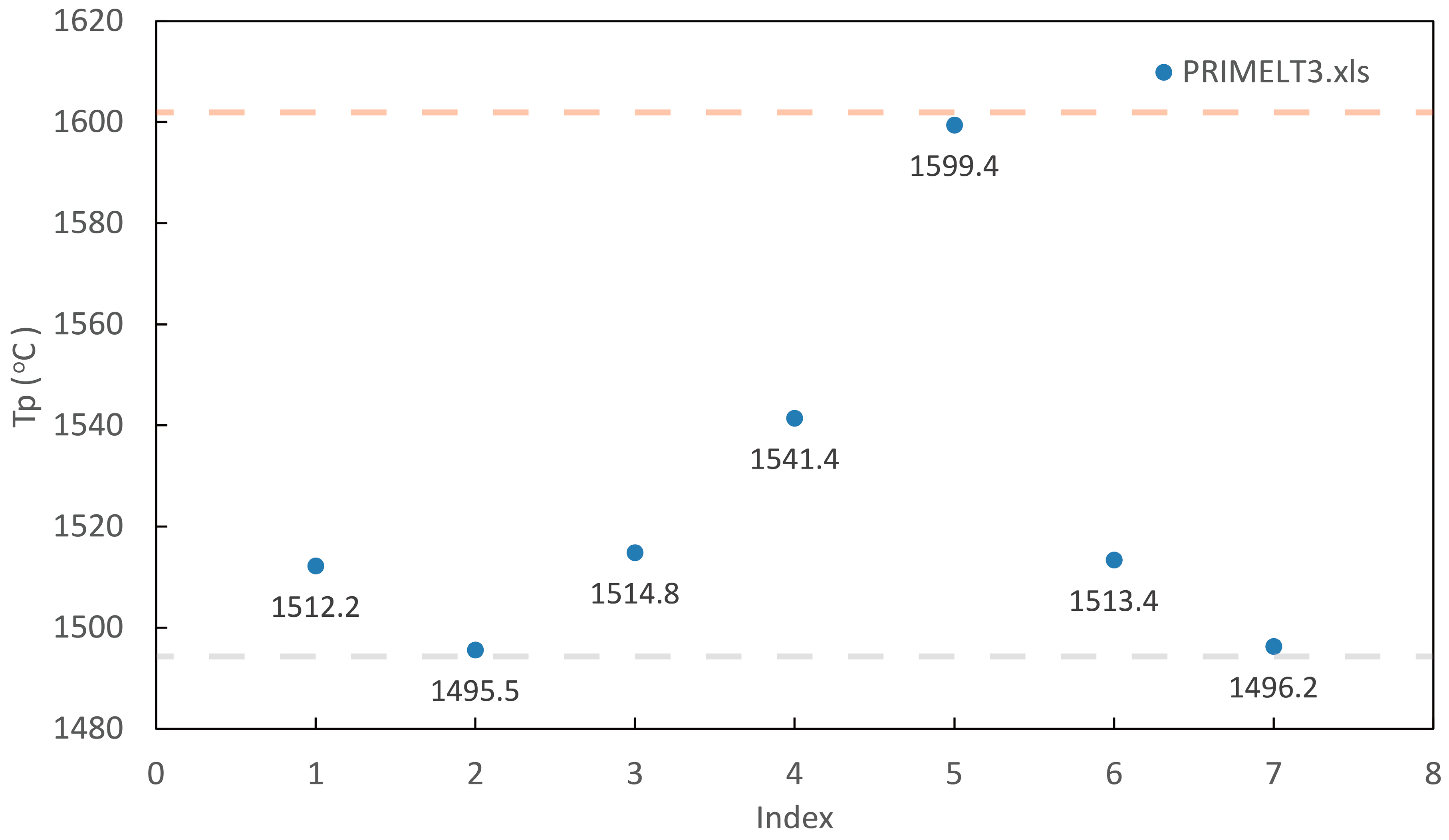


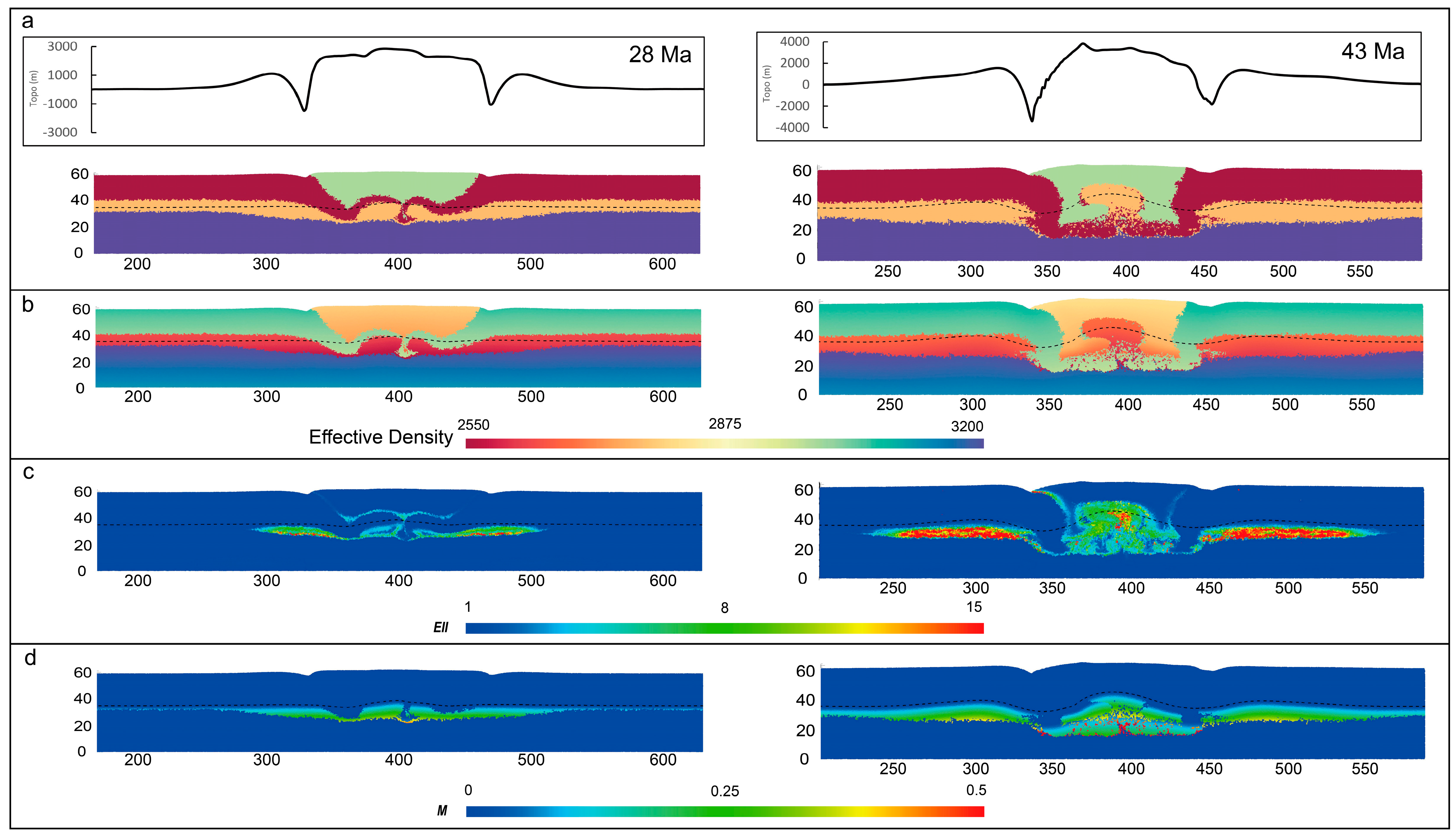
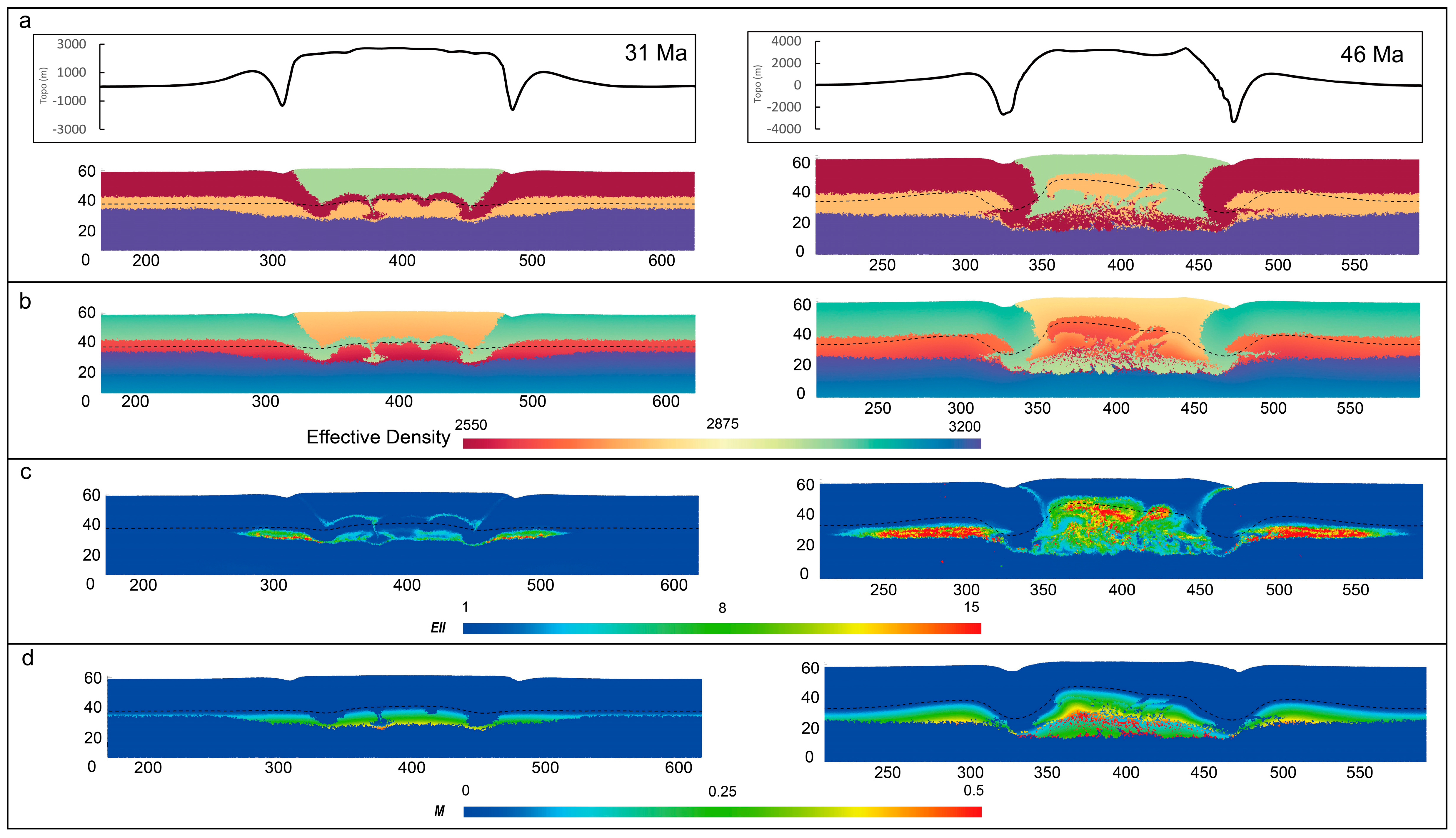
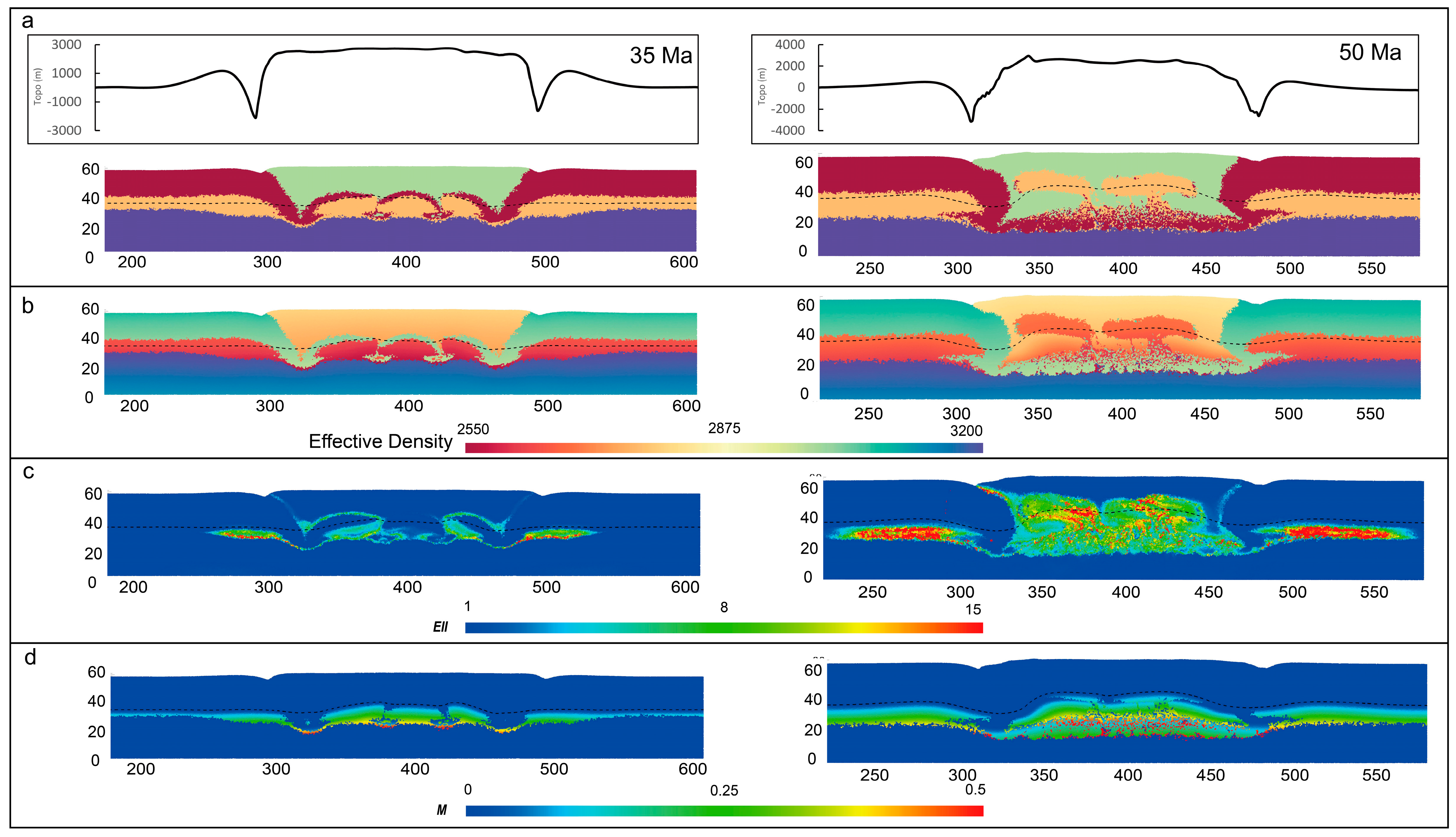
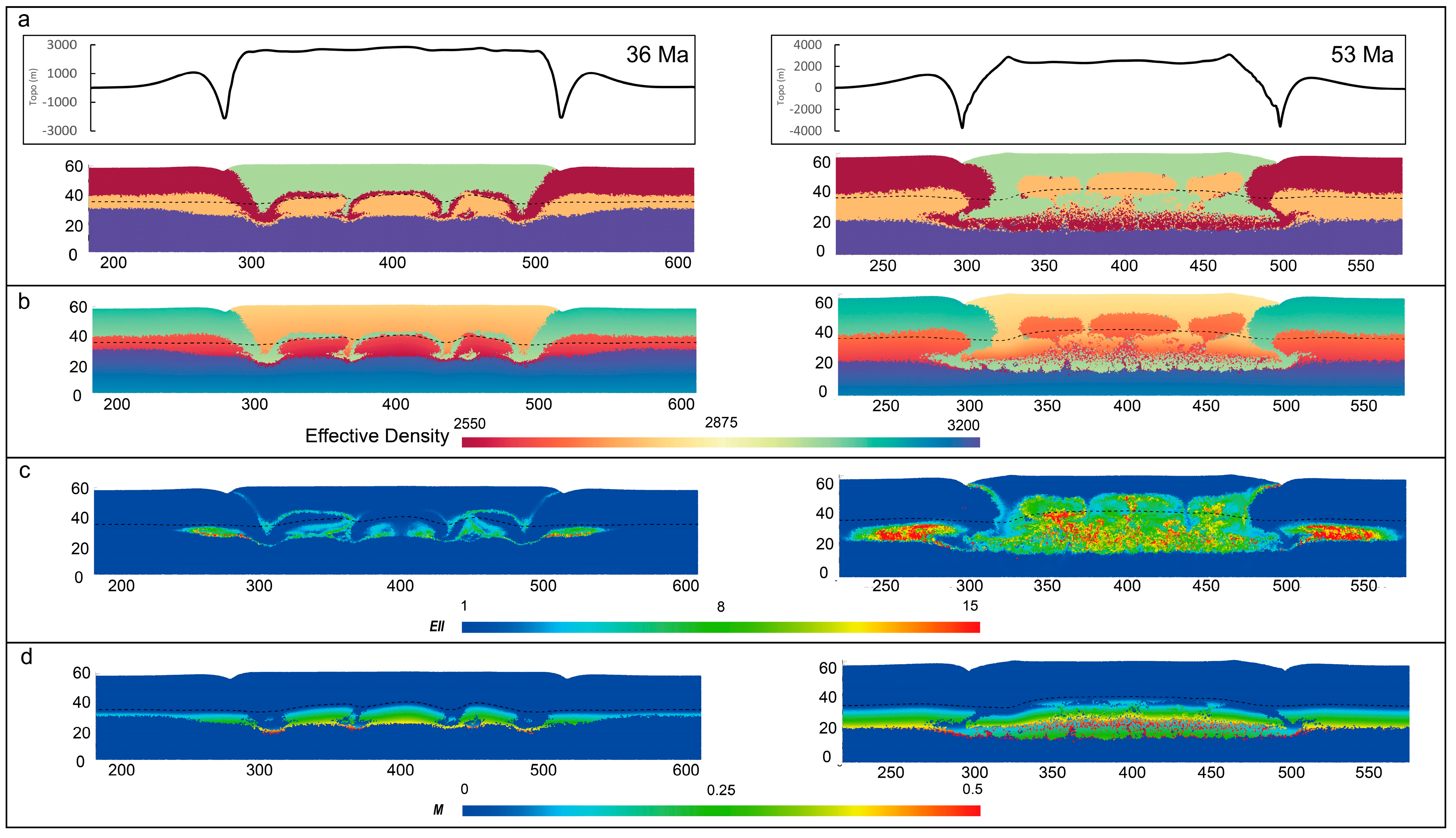
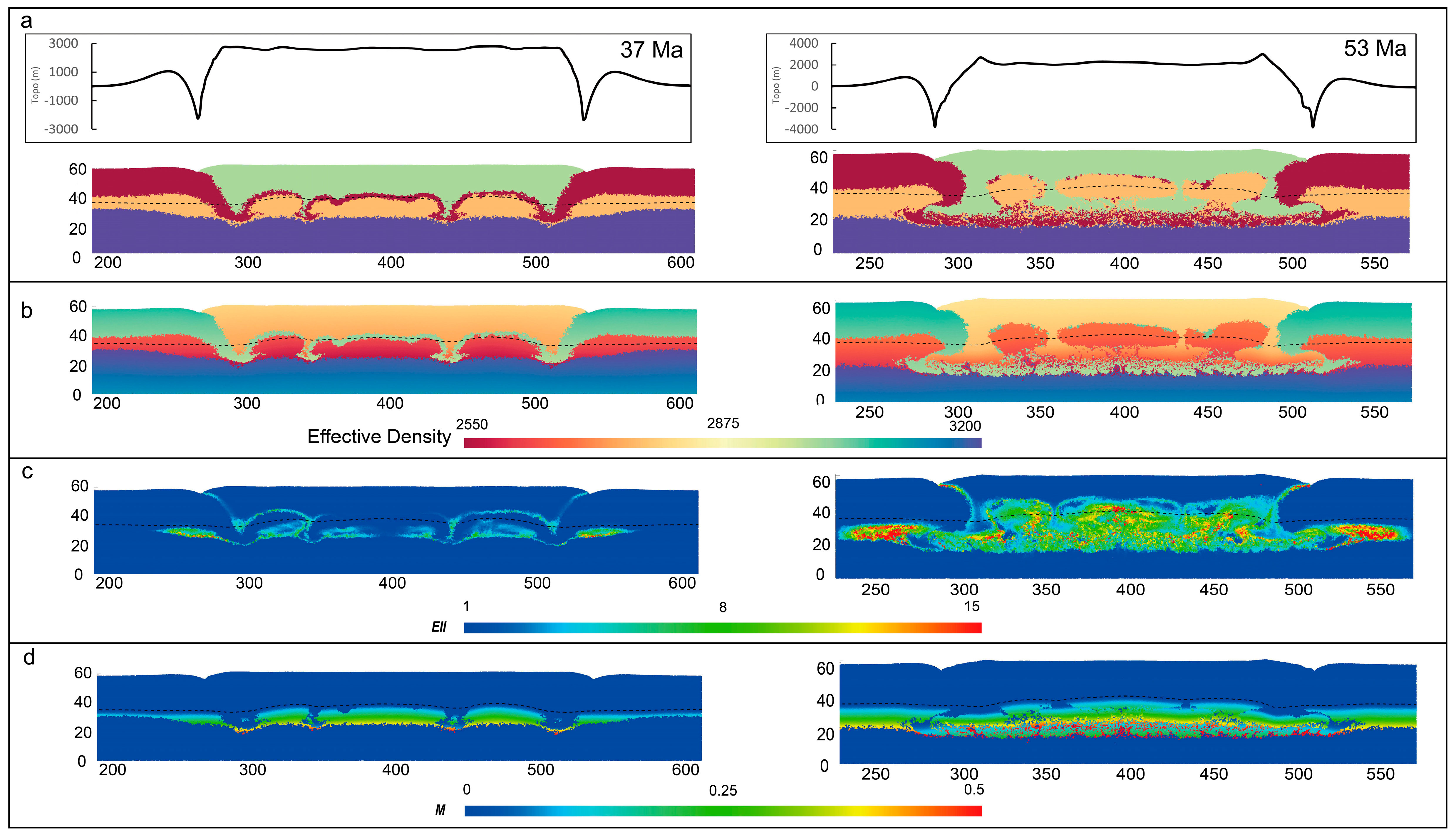
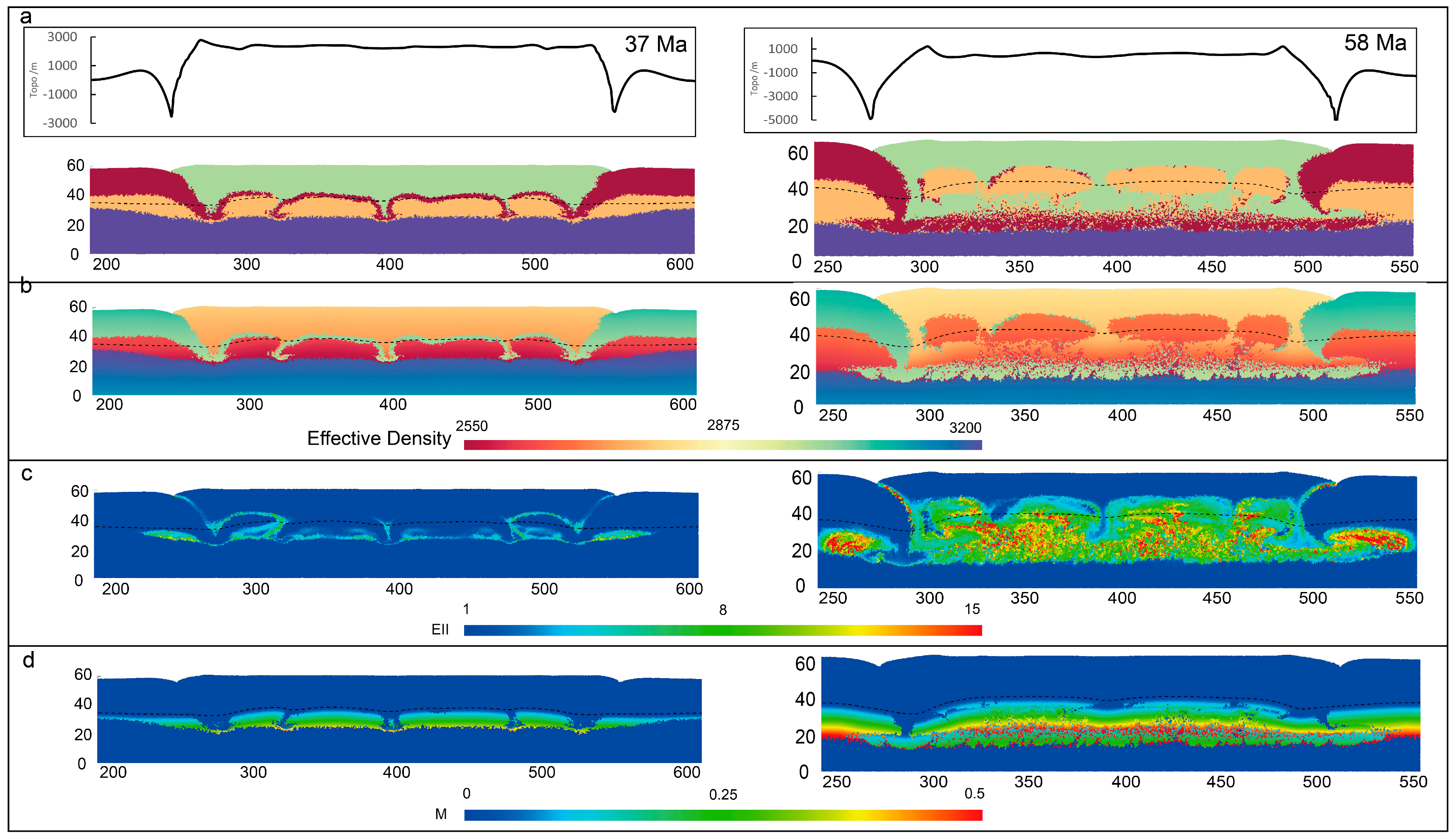

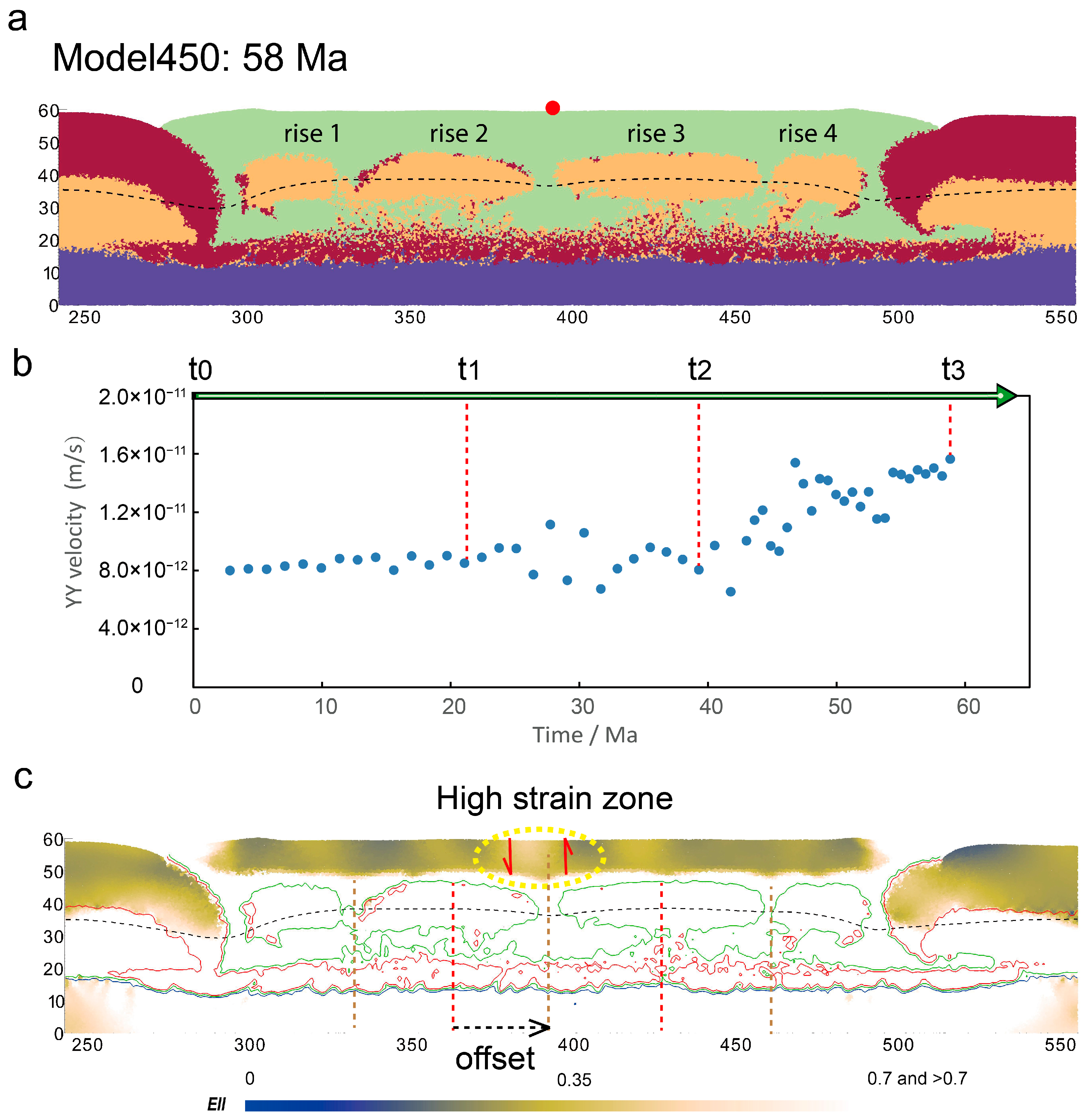
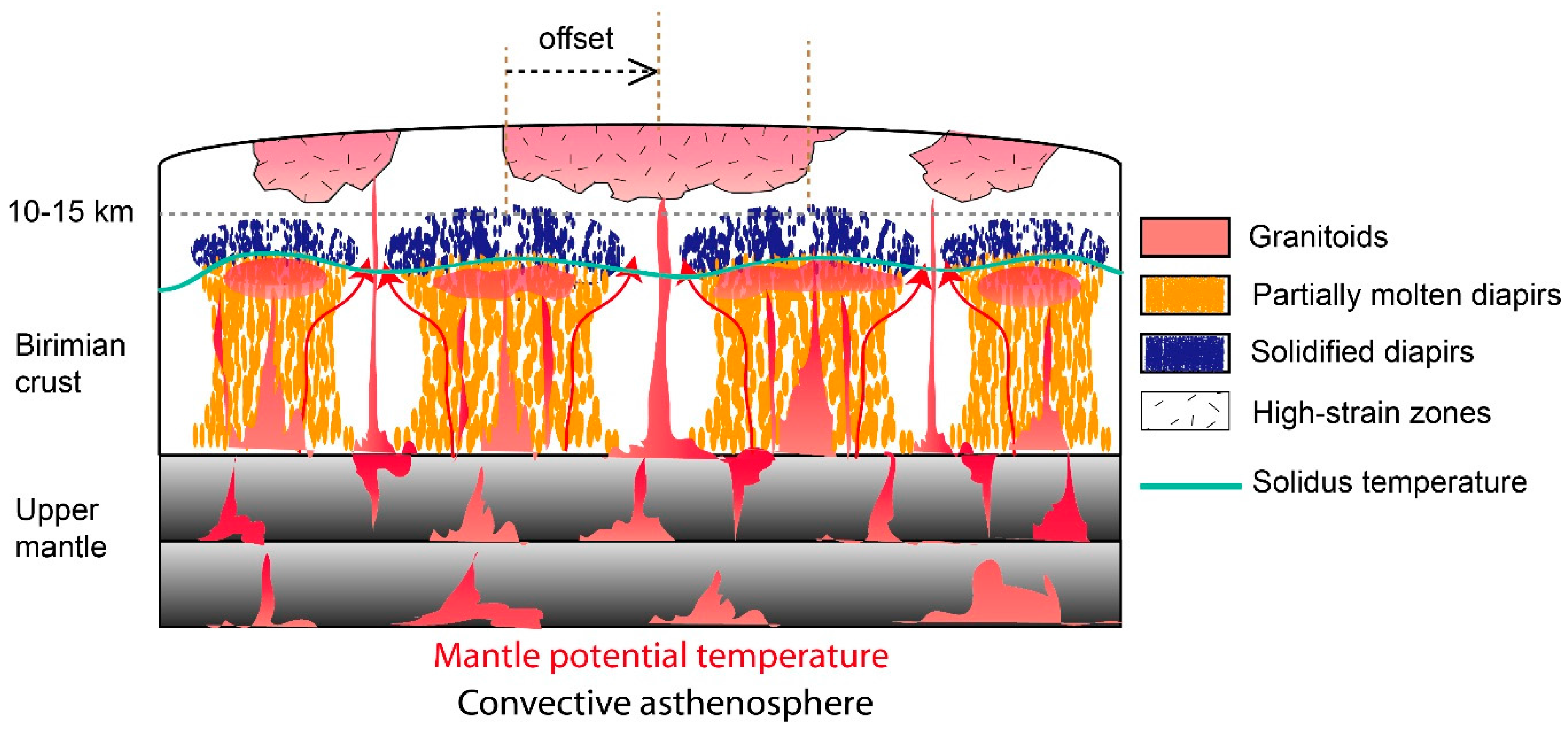
| Refferences | Hirdes et al. [28] | Ama Salah et al. [25] | Thomas et al. [29] | Galipp et al. [27] | Ama Salah et al. [25] | Soumaila. [26] | Soumaila. [26] |
|---|---|---|---|---|---|---|---|
| Sample | 1074 | AS-393 | EC2036 | KG 18 | AS-5 | 755 | 810 |
| Index | 1 | 2 | 3 | 4 | 5 | 6 | 7 |
| Location | Ghana Sefwi | Nigerian Liptako | Ghana Wa-Larwa | Ghana Sefwi | Nigerian Liptako | Nigerian Liptako | Nigerian Liptako |
| SiO2 a | 48.30 | 48.82 | 48.50 | 48.56 | 47.26 | 49.01 | 49.81 |
| TiO2 | 0.27 | 0.25 | 0.35 | 0.47 | 0.20 | 0.44 | 0.43 |
| Al2O3 | 11.52 | 12.77 | 11.20 | 10.68 | 10.03 | 11.34 | 10.75 |
| Fe2O3 | 0.14 | 0.12 | 0.17 | 0.23 | 0.10 | 0.22 | 0.21 |
| FeO | 9.55 | 9.27 | 9.56 | 9.91 | 10.66 | 9.50 | 9.23 |
| MnO | 0.16 | 0.16 | 0.16 | 0.17 | 0.18 | 0.16 | 0.17 |
| MgO | 17.98 | 17.34 | 18.09 | 19.13 | 21.43 | 18.03 | 17.36 |
| CaO | 10.32 | 10.14 | 10.56 | 9.34 | 9.10 | 9.93 | 9.70 |
| Na2O | 1.58 | 1.10 | 1.16 | 1.38 | 0.88 | 1.14 | 1.95 |
| K2O | 0.15 | 0.01 | 0.22 | 0.07 | 0.06 | 0.10 | 0.26 |
| T OL (°C) b | 1394.79 | 1375.32 | 1391.87 | 1414.03 | 1450.21 | 1390.57 | 1389.12 |
| T P (°C) c | 1529.53 | 1515.18 | 1531.79 | 1553.91 | 1599.65 | 1530.55 | 1515.78 |
| T P (°C) d | 1512.18 | 1495.54 | 1514.83 | 1541.44 | 1599.42 | 1513.38 | 1496.23 |
| OL Mg e | 0.92 | 0.91 | 0.92 | 0.92 | 0.92 | 0.92 | 0.91 |
| F AFM f | 0.29 | 0.29 | 0.30 | 0.32 | 0.34 | 0.31 | 0.31 |
| Pi (GPa) g | 3.9 | 3.7 | 3.9 | 4.2 | 5.2 | 3.9 | 3.7 |
| Pf (GPa) h | 1.3 | 1.1 | 1.3 | 1.3 | 2.8 | 1 | 1 |
| Width of Sediment (D = ?) | 200 km | 250 km | 290 km | 350 km | 400 km | 450 km |
|---|---|---|---|---|---|---|
| Exp # | Model200 | Model250 | Model290 | Model350 | Model400 | Model450 |
| Layer | A (MPa−n/s) | n | Q (KJ/mol) |
|---|---|---|---|
| Upper crust | 2.0 × 10−4 | 3.4 | 260 |
| Lower crust | 1.3 × 10−3 | 2.4 | 219 |
| Sediment | 3.2 × 10−4 | 2.3 | 154 |
| Upper most mantle | 7 × 10−4 | 3.3 | 520 |
| Parameter | Symbol | Value-Units |
|---|---|---|
| Density | ρupper | 3050 kg/m3 |
| ρlower | 2700 kg/m3 | |
| ρsediment | 2800 kg/m3 | |
| ρmantle | 3250 kg/m3 | |
| Width of sediment | D | km |
| Dislocation creep power law pre-exponential factor | A | MPa−n/s |
| Dislocation creep power law exponent | n | dimensionless |
| Power law creep activation energy | E | KJ/mol |
| Temperature | T | °C |
| Gas constant | R | 8.314 J mol−1·K−1 |
| Heat capacity | C | 1000 J/kg·K |
| Latent heat | lh | kJ/kg |
| Gravitational acceleration | g | 9.81 m/s2 |
| Friction angle for Drucker-Prager | φ | 8–20° |
| Cohesion for Drucker-Prager | σ | 5–10 Mpa |
| Viscosity limit | η | 1018 < η < 1023 Pa·s |
| Layer | Rock Type | (°C) | (°C) | |
|---|---|---|---|---|
| Upper crust | Diabase | 836 | 1200 | 0.3 |
| Lower crust | Quartzodiorite | 636 | 1200 | 0.8 |
| Sediment | Wet quartzite | 700 | 1200 | 0.8 |
© 2018 by the authors. Licensee MDPI, Basel, Switzerland. This article is an open access article distributed under the terms and conditions of the Creative Commons Attribution (CC BY) license (http://creativecommons.org/licenses/by/4.0/).
Share and Cite
Feng, X.; Wang, E.; Ganne, J.; Amponsah, P.; Martin, R. Role of Volcano-Sedimentary Basins in the Formation of Greenstone-Granitoid Belts in the West African Craton: A Numerical Model. Minerals 2018, 8, 73. https://doi.org/10.3390/min8020073
Feng X, Wang E, Ganne J, Amponsah P, Martin R. Role of Volcano-Sedimentary Basins in the Formation of Greenstone-Granitoid Belts in the West African Craton: A Numerical Model. Minerals. 2018; 8(2):73. https://doi.org/10.3390/min8020073
Chicago/Turabian StyleFeng, Xiaojun, Enyuan Wang, Jérôme Ganne, Prince Amponsah, and Roland Martin. 2018. "Role of Volcano-Sedimentary Basins in the Formation of Greenstone-Granitoid Belts in the West African Craton: A Numerical Model" Minerals 8, no. 2: 73. https://doi.org/10.3390/min8020073
APA StyleFeng, X., Wang, E., Ganne, J., Amponsah, P., & Martin, R. (2018). Role of Volcano-Sedimentary Basins in the Formation of Greenstone-Granitoid Belts in the West African Craton: A Numerical Model. Minerals, 8(2), 73. https://doi.org/10.3390/min8020073






